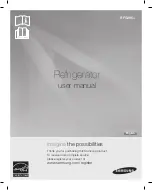
6
Care and Cleaning
To avoid damage and help
the refrigerator run as efficiently as
possible, clean the condenser and air
vents periodically.
Keep your refrigerator and freezer clean to prevent odor build-up. Wipe up any spills
immediately and clean both sections at least twice a year.
Never
use metallic scouring
pads, brushes, abrasive cleaners or strong alkaline solutions on any surface.
Do not
wash any removable parts in a dishwasher.
Always unplug the power cord from the wall outlet before cleaning.
Turning
the refrigerator control to OFF does not disconnect power to the controls, light bulb,
or other electrical components.
Inside
Wash inside surfaces of the refrigerator and freezer with a solution of 2 tablespoons
baking soda in 1 quart warm water. Rinse and dry thoroughly.
Be sure to wring
excess water out of sponge or cloth before cleaning around the controls, light
bulb, or any electrical parts.
Wash removable parts with baking soda solution or mild detergent and warm water.
DO NOT USE HARSH CLEANERS ON THESE SURFACES.
Rinse and dry thoroughly.
Clean the door gaskets with mild suds, rinse with clear water and wipe dry. Do not
use razor blades or other sharp instruments which can scratch the appliance surface
when removing adhesive labels. Any glue left from the tape or energy label can be
removed with a mixture of warm water and mild detergent, or, touch the residue with
the sticky side of tape already removed.
DO NOT REMOVE THE SERIAL PLATE.
Outside
Wash the cabinet and handles with warm water and mild liquid detergent. Rinse well
and wipe dry with a clean soft cloth. Do not use commercial household cleaners,
ammonia, or alcohol to clean handles.
Clean stainless steel (some models) front and handles with hot soapy water and a
dishcloth. Rinse with clean water and a soft cloth. Wipe stubborn spots with an
ammonia-soaked paper towel, and rinse. Cleaners made especially for stainless steel,
such as Sheila Shine, trademark of Sheila Shine, Inc., Stainless Steel Magic,
trademark of Magic American Corp., or similar products are suggested. Always
follow
manufacturer's instructions. Wash the rest of the cabinet with warm water and mild
Damp objects stick to cold
metal surfaces. Do not touch refrigerated
surfaces with wet or damp hands.
Meat Keeper
(some models)
The temperature in the Meat Keeper drawer can be made colder than the rest of the
refrigerator compartment by adjusting the Chilled Air Control. Meat will be partially
frozen and may be kept fresh longer than if stored on a refrigerator shelf.
Before placing items in the Meat Keeper, follow these steps to keep the meat fresh:
1.
Carefully handle meat with clean hands and always keep the compartment
clean.
2.
Store meat in its original wrapper. If necessary, overwrap in plastic wrap or foil
to prevent drying. Wrap fish tightly to prevent odor transfer to other foods.
3.
If spoilage ever occurs, disinfect the compartment with liquid chlorine bleach
following label directions. Then, rinse with a solution of baking soda and water.
Rinse with clear water and dry.
Adjustable Chilled Air Duct
(some models)
The Chilled Air Duct, which distributes cold air to the Meat Keeper drawer, can be
adjusted to accommodate repositioning of the shelf. However, the shelf has a limited
range of positions in which the Chilled Air Duct will reach.
The Chilled Air Duct can also switch sides, should you wish to move the split cantilever
shelf. To change sides:
1.
Remove the Meat Keeper drawer and shelf. Grasp the air duct near top and slide
toward you until duct is free from grooves.
2.
Slide off hole cover on opposite side. Insert the lip of the air duct in grooves of
new hole and slide back.
3.
Slide hole cover over original hole.
4.
Replace shelf and insert drawer.
Adjusting the Chilled Air Duct
Hole Cover
Air Duct
Lower portion of
air duct slides up
or down.
Air Outlet Box
Hole cover and air duct
slide into grooves on
bottom of air outlet box.
Fresh Food Storage
(continued)
Chilled Air Control
Summary of Contents for FRT22INLHC1
Page 17: ...NOTES ...



































